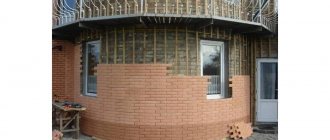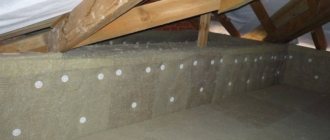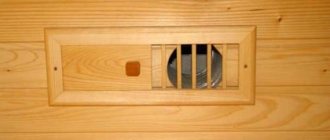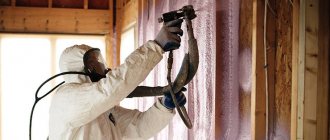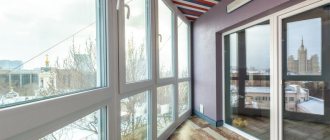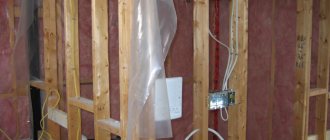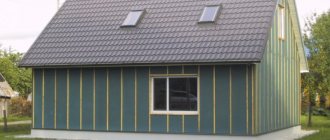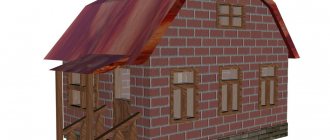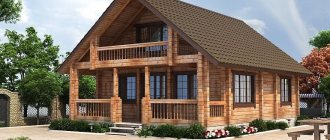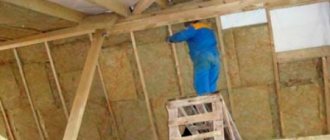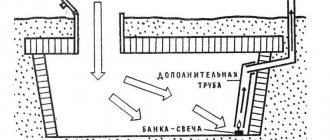Experienced owners believe that insulating the balcony from the outside is the best option for preserving internal heat. And they are absolutely right: after all, this saves up to 30% of all heating costs. In addition, in this way you can save space inside the room, which will inevitably be “eaten up” by the insulation during interior decoration.
However, for residents of high-rise buildings, external insulation of the balcony is only possible through the use of the services of industrial climbers. In addition, thermal insulation of a balcony from the outside often involves a complete change in its design and exterior - you need to be prepared for significant changes, among which there are, of course, many more positive ones.
Advantages
The advantages include the transfer of the “cold” part of the outer wall that is most susceptible to cooling into the room.
This occurs by creating an additional insulating layer on the outside, which helps retain heat in the internal space.
In this case, there is no need to create a heat-reflecting layer, i.e. no need to lay an additional layer of foil foam. Humid air freely leaves the warm room through pores in the wall, without being delayed along the way and without encountering a “cold damper”, as would be the case with internal insulation. In other words, there is no formation of wet condensation, which can lead to dampness, mold and destruction of thermal insulation.
Insulating the balcony from the outside saves internal space - it allows you to minimally use the internal thermal insulation capabilities. Thus, the external finishing allows the use of a thinner layer of insulation, thereby saving extra centimeters of space. If desired, the owners can change the appearance of the balcony using a wide variety of materials for decoration.
How to insulate a balcony from the outside
Insulating a balcony from the outside on your own is problematic. It is better to entrust the process to professional climbers. When choosing materials in a store, take into account the performance characteristics. In addition, you need to take into account the complexity of installation work.
Step-by-step instructions will help you do everything right. The process of insulating a balcony from the outside consists of the following steps:
- Buy a primer and apply it to the surface.
- Glue foam or sheets of extruded polystyrene foam. Take into account the wind load, secure the sheets with mushroom dowels.
- The thermal insulation of the balcony must be covered with reinforcing mesh; it must be fixed with dowels with recesses.
- Cover the reinforcing layer with glue, apply 2 layers. When it hardens, take a good spatula and remove any drips and uneven spots. After this, everything is ready for finishing work.
- Paint the balcony or apply facade plaster.
For high-quality insulation from the outside, you can buy mineral insulation for the balcony. Basalt wool has proven itself well; it is produced in slabs. Their installation will require the installation of sheathing and vapor barrier. You can’t do without a layer of waterproofing - it will protect the insulating layer from getting wet.
The use of penoplex gives excellent results. Video below.
Methods
Methods of external insulation of a balcony include window insulation, namely the replacement of old worn-out window structures with new metal-plastic double-glazed windows. Insulation of balconies from the outside is carried out both from the front walls and from the ceiling and side walls.
Part of the insulation is carried outside, that is, practically to the street. With external insulation, not a continuous, but an interrupted thermal insulation layer is created. Uniformity in this case is not so important: some part is exposed in the outer areas, and the other remains inside. The complex creates the same layer, only not a single one, but consisting of several elements.
What you need to know about external insulation
External thermal insulation is necessary if there is high humidity on the balcony, the walls often get wet, or they are colder than the air temperature inside. Insulation has many benefits. The main one is the removal of the “dew point” outside.
Dew point is the temperature at which air humidity reaches 100% and condensation forms on the walls. When walls get wet, dampness and mold appear. When insulating a balcony from the outside, you don’t have to worry about this.
Insulating the loggia from the outside has other advantages:
- saving usable space;
- simplicity of finishing work;
- the wall is warm at any temperature;
- there is no need to vacate the balcony.
If the balcony parapet is recessed in relation to the extreme point of the side slabs, there is no need to erect additional structures.
There are many advantages, but there are also disadvantages: high cost, complexity of work (you need an aerial platform, climbing equipment).
Before insulating a loggia or balcony, you will need to coordinate the upcoming work with your housemates, architectural and construction organizations and housing and communal services.
Materials
In this case, the following can be used as thermal insulation materials:
- expanded polystyrene;
- mineral wool;
- sandwich panels.
Most often, polystyrene foam and mineral (basalt) wool are used as insulation. The positive qualities of these materials are their low cost, light weight, low thermal conductivity, moisture resistance and resistance to mold.
Expanded polystyrene or polystyrene is most preferable - it is easy to work with, while working with mineral wool requires gloves and respiratory protection. Sandwich panels are heavy for balconies, so they are used very rarely.
Fixation
Typically, a special frame made of slatted timber is used to fix the thermal insulation material. Metal hangers are fastened in advance, onto which profiles will later be installed to secure the façade finishing. Expanded polystyrene is fixed simultaneously with special dowels and polyurethane glue. All seams are sealed with polyurethane foam.
From the outside, siding is hung on the insulation using metal profiles, PVC panels, lining or frame are simply plastered as desired.
How to choose exterior finishing?
When choosing what to cover the outside of a balcony with, many apartment owners primarily consider that the material should be as cheap as possible. At the same time, it must look good, protect the insulation, and be sufficiently reliable and durable. We offer several options available to suit your budget:
- Vinyl or metal siding is an affordable and easy-to-install material; it is made of steel. It can be galvanized or covered with vinyl, which protects the sheets well from scratches and rust. The material is relatively lightweight, installation does not take much time, and the siding will last for decades.
- Lining. If treated correctly, the board will not be afraid of moisture and parasites, but it will have to be processed at least once a year, which incurs additional costs. The view from the balcony will be original, but the material is more suitable for a log house than for an apartment.
- Polycarbonate. This is a durable and flexible material, does not allow air and moisture to pass through, is light in weight, can be transparent or dense, can be painted in different colors, and fits well with modern room designs. No shortcomings could be found.
Glazing
Glazing is the installation of a special window unit, most often made of plastic. If such a design were truly effective at containing heat, then additional insulation would not be required. The problem is that the described blocks increase the temperature by only a couple of degrees - plastic and double-glazed windows can only prevent precipitation and wind.
The window unit, the installation of which is accompanied by insulation of balconies and loggias, is a kind of “cover” - usually the extension is open, and after glazing it is closed on all sides. Then they begin complex insulation.
Preparatory activities
Insulating a balcony from the outside needs to start with planning. Make a technical calculation or find ready-made solutions offered by specialists.
It wouldn't hurt to assess the condition of the parapet, the scope of work, and the upcoming costs. All this is of great importance when choosing a material, the main requirement for which is high moisture resistance.
- Sprayed polyurethane foam is best suited for insulating parapets made of corrugated sheets and metal structures. There is no need to create holding structures for it. It covers the cavities between the rods and stiffeners. This material is not cheap, and the application process is labor-intensive.
Spray polyurethane foam
- Expanded polystyrene (foam) is a moisture-resistant, lightweight material with low thermal conductivity. This is a fairly economical option, but it is not durable or highly durable.
- Penoplex is inexpensive and has high sound and heat insulation properties. He is easy to work with. Penoplex is significantly superior to polystyrene foam in strength and durability.
- Sandwich panels are rarely used due to their heavy weight. It is not recommended to use mineral wool for external insulation of balconies. It needs a crate. And it is not distinguished by high moisture resistance.
More about wall structures
The insulation of loggia walls is, in fact, also external. Despite the fact that the work is already being carried out in a room protected on all sides by a window block, these walls have no relation to the living space.
Work begins with cleaning the base. This is necessary so that the thermal insulation boards lay normally on the surface. After cleaning the surface, they begin gluing the slabs: the composition is applied, the slab is glued. It is necessary to ensure that the slabs lie flat. The joints are filled with construction foam.
Then they move on to doweling to make the structure more reliable. For reliability, a reinforcing mesh is installed on the insulation between two layers of glue. Once everything is dry, you can apply a layer of finishing.
Floor insulation or the most important part of thermal insulation
Not a single room in the house needs underfloor heating, like a loggia or balcony. The advantages of heated floors include the fact that they distribute heat over the entire area of the room, moreover, convection and radiation spread straight upward, without leaving overheated or weakly heated areas, as is the case with radiator heating. Usually the temperature at the level of the feet reaches 26-28 degrees, and at the level of the head 20-22. Cable heating systems are represented on our market by products of Ceilhit (Spain), Devi (Denmark), Ensto (Finland), Nexans (Norway), SST (Russia), etc.
The most common are single- and double-core heating cables. For a single-core cable, the level of electromagnetic radiation is 60 times less than the maximum permissible norm, and for a two-core cable - 300 times. Two-core ones are more modern and expensive. The big advantage of using them is the simpler installation method. The fact is that a single-core cable must be placed on the floor in such a way that both of its current-carrying ends - the initial and final ones - are connected to the thermostat, and this is sometimes inconvenient. In the case of a two-wire wire, it is not necessary to connect the second end to the thermostat. To install heated floors, cables of a fixed length are used, which cannot be changed arbitrarily. The fact is that the length of the cable determines its power required to heat a particular room. However, when calculating power, it is necessary to take into account not only the area of the room, but also its volume, window area, and wall thickness.
